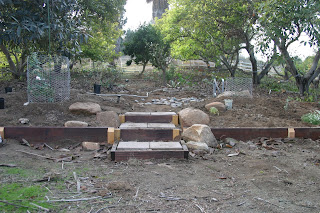So my parent's yard when I got there 2 years ago seemed almost like a lost cause. 150 avocado trees, dead lawn, ugly queen palms, 20 various fruit trees and more dead lawn and about 5 half dead rose bushes as "colour" for the front. It was pretty embarrassing to tell people "Im a landscape horticulturalist" and for them to see "lack of horticulture" pulling up to the house.
 The beginning of " Its too late to turn around."
The beginning of " Its too late to turn around."


 as of mid march
as of mid marchThe most noteworthy thing about gardeners is that they are always optimistic,
always enterprising, and never satisfied. They always look forward
to doing something better than they have ever done before.
always enterprising, and never satisfied. They always look forward
to doing something better than they have ever done before.
~ Vita Sackville-West
Personally gardening comes first before Landscape design. For me it is about trying new or uncommon varieties or species. Trying something and examining how plants do in certain situations is the best way to learn and figure out what works and what doesn't

 sneak peak of the back.
sneak peak of the back. Fast forward 2 years and Im guessing most people would think the yard as a horticultural explosion of a mess. Ill be the first to admit, I am a collector. Working in the Nursery industry, I want to get and try many different plants that comes in. Which usually makes a yard come out looking kind of like a patch work quilt made from random tie dye shirts. I tried various plant combos so there are little vignettes with certain plant combinations that read great together but then as a whole, they get lost. Right now the yard is making a progression of green and gold blending into silvers..... I realize that too much Silver can wash things out and too much gold can make the eyes do crazy things. Who doesn't like silver and gold?

 Mid may Julian CA.
Mid may Julian CA.